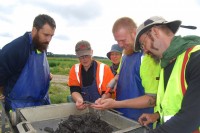 Archaeologists excavating a 9,200 year-old settlement on the banks of the long-defunct Lake Vesan near the Baltic Sea coast in Sölvesborg, southern Sweden, have discovered evidence of a massive fish fermentation operation. They found pine bark and an incredibly dense concentration of fish bones, about 30,000 of them per square meter. Underneath the fish bone layer was an oblong pit dug into the clay soil. The pit was rimmed with five larger postholes and 32 smaller stakeholes.
Archaeologists excavating a 9,200 year-old settlement on the banks of the long-defunct Lake Vesan near the Baltic Sea coast in Sölvesborg, southern Sweden, have discovered evidence of a massive fish fermentation operation. They found pine bark and an incredibly dense concentration of fish bones, about 30,000 of them per square meter. Underneath the fish bone layer was an oblong pit dug into the clay soil. The pit was rimmed with five larger postholes and 32 smaller stakeholes.
The team looked to ethnographic studies of current circumpolar societies which rely on fish as their primary source of sustenance for comparison. They found that these fish-dependent cultures cope with large catches over a short fishing season by fermenting the fish. In a cold climate with a very short summer, there just isn’t the time to dry or smoke all the fish necessary to sustain life over the long winter. Some areas are too damp for drying to work at all. The cold climate has one major advantage: it is possible to ferment food without adding salt. Traditional circumpolar people like Inuits from Greenland, the Jawina in Kamchatka and the Karelians in Finland, don’t use salt. They dig holes in the ground, fill them with fish and cover the pits with animal skins, stones or earth, much like the people on the shores of Lake Vesan may have been doing 9,200 years ago.
Analysis of the remains suggests that fish had been fermented in that pit. The presence of a small number of wild boar and seal remains may indicate the Mesolithic fishermen wrapped the fish in animal skins that were then attached to the posts in the holes. The pit in that scenario provided air circulation underneath the fermenting fish. Once fermented, the flesh could be removed and the bones dumped into the pit. Another possibility is that the fish were in a pit lined with seal and boar remains (blubber and fat acidify the fish and aid in the fermentation process) and covered with pine bark. Pine bark is also acidic and would help ensure that the fish began to ferment right away rather than just rotting.
Using fine mesh sieves to sift through the soil and capture every tiny fish bone and calculating from the number of bones found at the site, the team discovered that at least 60 tons of freshwater fish from the lake, mostly common roach, were caught there. It’s the world’s earliest evidence of fermentation, and it has the potential to rewrite the timeline of the Early Mesolithic.
Traps to capture large numbers of fish and game have been found before from this period, large enough numbers that some form of storage would have been necessary. Without direct archaeological evidence of long-term and large-scale storage, however, the preservation of food has been seen as the province of more complex, sedentary Neolithic farming communities which have pottery, granaries and silos to attest to their long-term storage of grain. This new direct evidence of storage by fermentation in the Mesolithic indicates a more socially complex culture with previously unrecognized technological skill and adaptability to a rapidly changing environment.
The discovery is also an indication that Nordic societies were far more developed 9,200 years ago than what was previously believed. The findings are important as it is usually argued that people in the north lived relatively mobile lives, while people in the Levant – a large area in the Middle East – became settled and began to farm and raise cattle much earlier.
“These findings indicate a different time line, with Nordic foragers settling much earlier and starting to take advantage of the lakes and sea to harvest and process fish. From a global perspective, the development in the Nordic region could correspond to that of the Middle East at the time,” says Adam Boethius.
That’s not to say that this was a farming community. There is no evidence of cultivation of crops. The Nordic peoples of the Early Mesolithic were still foragers, but the scale of the fermentation indicates they may have been semi-sedentary, ie, mobile, but with a regularly maintained home base. Judging from the kind of game and marine life killed at what stages in life, the lakeside settlement was occupied most of the year, from late summer to late spring, particularly in the coldest part of the winter. That makes this site the earliest winter-summer settlement in southern Scandinavia and the earliest settlement of any kind on the east coast of Sweden.
The findings have been published in the Journal of Archaeological Science.